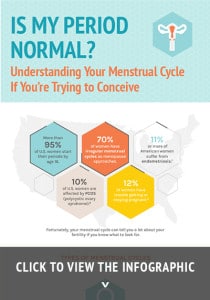Your Menstrual Cycle May Reveal the Culprit to Your Trouble Conceiving
One in eight couples will experience infertility, defined as the inability to conceive after 6 months to a year of unprotected intercourse, depending on the female partner’s age. Many of the causes behind infertility are unknown until testing has been completed. However there is one sign that women can look for in regards to their fertility: the regularity of her menstrual cycle.
The menstrual cycle is directly related to ovulation (the release of an egg). But what if ovulation isn’t occurring, how do you know and what can be done to help? Understanding your menstrual cycle could offer important insights into your fertility.
Understanding Your Menstrual Cycle: It’s More than Just Your Period

The menstrual cycle is a series of changes a woman’s body goes through each month whereby the ovary releases an egg and the uterus prepares for pregnancy. The menstrual cycle includes two phases: the follicular phase and the luteal phase.
Phase One: The Follicular Phase
The first day of your menses—or period—is day 1 of your cycle and the start of the follicular phase. During the follicular phase, the hypothalamus and pituitary glands in the brain release a hormone known as follicle-stimulating hormone (FSH). FSH stimulates the development of a follicle, which is a tiny fluid-filled sac within the ovary containing a maturing egg. The follicle also secretes estrogen, which produces mid-cycle changes in the cervical mucus and stimulates the lining of the uterus to thicken. These changes help prepare the uterus to receive the embryo. The follicular phase starts on day 1 of your menstrual cycle, the first day of day of your period, and concludes with a mature egg ready for release around 13 days later.
Phase Two: The Luteal Phase
The start of the second phase, or luteal phase, begins with ovulation. There is a drastic surge in luteinizing hormone (LH), also released by the pituitary gland, causing the follicle to break open and release the mature egg into the Fallopian tube. During a woman’s reproductive years, a woman usually releases a single mature egg each month, in a process known as ovulation.
Cervical mucus is most receptive to sperm around this point in the cycle and a woman has the best chances of conceiving leading up to and during ovulation. When a couple has intercourse around the time of ovulation, sperm swim through the cervical mucus, into the uterus and along the Fallopian tube, where they meet the egg. The egg has the capacity to be fertilized for about 24 hours after it is released from the follicle.
Once ovulation occurs, the follicle that produced the egg becomes a functioning cyst called the corpus luteum. The corpus luteum produces progesterone, which prepares the lining of the uterus for implantation of the fertilized egg resulting in pregnancy.
If fertilization does not occur, the egg passes through the uterus, and the corpus luteum ceases to function on about 14 days after ovulation. The uterine lining then breaks down and is shed several days later as the next menstrual cycle begins.
What is considered a “normal” menstrual cycle?
There is such thing as a normal cycle. The menstrual cycle is essential for the maturation and ovulation of an egg in addition to the preparation of the uterus for implantation. A normal menstrual interval ranges from 21 to 35 days and indicates that a woman is likely ovulating regularly. The portion of the cycle where the uterine lining is shed, also known as the period, in a normal cycle lasts between 2 and 7 days. If there is very little bleeding during the period (less than 2 days or very scant amount) or the bleeding lasts for greater than 7 days then it may indicate an abnormality within the cavity such as polyps, fibroids, cancer, or an infection of the uterus, or irregular ovulation. Cycles of a normal length suggest regular ovulation and that all of the sex hormones are balanced to support natural conception.
What does it mean if the number of days in my menstrual cycle or between periods has increased all of a sudden?
If the cycle length is still in the normal range described above (between 21 to 35 days) then the change is likely normal variation. However, if the cycle extends beyond 35 days, the cycle might be considered irregular raising concerns as to whether or not ovulation is occurring since longer cycles are caused by a lack of regular ovulation.
During a normal cycle, it is the fall of progesterone that brings upon bleeding. If a follicle does not mature and ovulate, progesterone is never released and the lining of the uterus continues to build in response to estrogen. Eventually, the lining gets so thick that it becomes unstable and, like a tower of blocks, eventually falls and bleeding occurs. This bleeding can be unpredictable, and oftentimes very heavy and lasting a prolonged period of time.
How can I time my ovulation to get pregnant?
It is a common misconception that the luteal phase begins around day 14 of your cycle; in fact, it can more easily be determined by counting 14 days prior to the start of your cycle. The length of a normal cycle is anywhere between 21 and 35 days, so if you are counting from the start of the cycle you may be missing the time of ovulation by as much as a week. To calculate when ovulation is likely to occur determine how long your cycle lasts and subtract 14 days from the predicted end of the next cycle. Another option is to use an at-home urine-based ovulation predictor kit. These at-home fertility tests look for the surge of luteinizing hormone (LH) that occurs 1 to 2 days prior to ovulation. It’s important to note that the ovulation predictor kits are not 100% accurate. These can be useful for women who have regular cycles, however, if you’re having irregular cycles, your levels of luteinizing hormone (LH)—the hormone such tests attempt to detect—could be outside of the normal ranges, making this test potentially unreliable for you. Learn more about how to determine your fertile window.
If I am not ovulating, what might be the cause?
There are many causes of anovulation, the medical term used to describe when ovaries do not release mature eggs on a regular basis. Irregularities with the thyroid gland or elevations of the hormone prolactin can disrupt the brain’s ability to communicate with the ovary and result in anovulation. In addition, polycystic ovary syndrome (PCOS), a syndrome caused by imbalanced sex hormones, can also cause failed ovulation. Not only do these hormonal imbalances lead to problems with ovulation and therefore fertility, but they may also increase the risk of miscarriage.
Can I still get pregnant if my menstrual cycle is not normal?
Yes, even if your menstrual cycle is abnormal, you may still conceive on your own. However, it may be a little more challenging, especially if you’re trying to determine your most fertile window based on your menstrual cycle. However, it’s important to realize that there are many situations in which ovulation does not occur, and thus, conception cannot occur naturally. There are also instances in which scar tissue in the uterine cavity or premature menopause can be factors limiting conception. Despite these factors though, there are a range of fertility treatment options that can help almost everyone conceive.
When should I seek help?
Irregular or no ovulation makes conception very difficult without intervention. If you do not have a normal monthly menses, no matter the amount how long you have been trying to conceive, you should be evaluated by a fertility specialist. Any woman under 35 years of age with normal cycles who has not become pregnant after 1 year of trying should see fertility specialist. If you are 35 or older with a normal menstrual cycle and have been trying for 6 months without success, you should seek an evaluation as well. Normal menstruation indicates that you are ovulating; however, there are other reasons why you may not be able to get pregnant, and these should also be evaluated.
Medical contribution by: Stephanie Beall, M.D., Ph.D., of Shady Grove Fertility’s Towson, MD and Columbia, MD offices and Kara Nguyen, M.D., MPH of Shady Grove Fertility’s Reading, PA office and Harrisburg, MD offices.
Editors Note: This post was originally published in July 2014 and has been updated for accuracy and comprehensiveness as of March 30, 2017.
If you do not have a normal menstrual cycle and are having trouble conceiving, a fertility work-up may help determine if you are ovulating or if there are other factors. Shady Grove Fertility’s team of dedicated New Patient Liaisons is available to answer your questions and schedule a consultation with a physician. Call 877-971-7755 or click to schedule an appointment.
At Shady Grove Fertility, we’re here to give you the caring support you deserve as you start or grow your family. As a leading fertility and IVF center of excellence, we offer patients individualized care, innovative financial options, over 30 accepted insurance plans, and pregnancy rates among the highest of all national centers. We offer patients the convenience of 19 full-service and 6 satellite locations across Maryland, Pennsylvania, Virginia, and Washington, D.C. More than 1,700 physicians choose Shady Grove Fertility to refer their patients, and more than 96 percent of our patients say they would recommend Shady Grove Fertility’s 39 physicians to a friend. With 10 Shady Grove Fertility babies born each day, your dream of starting or growing your family is within reach.






